Rajasthan Board RBSE Class 11 Physical Geography Chapter 18 Movements of Ocean Water
RBSE Class 11 Physical Geography Chapter 18 Text Book Questions
RBSE Class 11 Physical Geography Chapter 18 Multiple Choice Questions
Question 1.
How many types of water motions are found in the oceans?
(a) 1
(b) 2
(c) 3
(d) 4
Answer:
(c) 3
Question 2.
What is the cause of the spring tide?
(a) Coastline being indented
(b) when the sun, the earth and the moon are in the position of right angle
(c) when the sun, the earth and the moon are in a straight line
(d) None of the above
Answer:
(c) when the sun, the earth and the moon are in a straight line
Question 3.
At what time interval does the tide occur?
(a) 12 hours 26 minutes
(b) 12 hours 56 minutes
(c) 12 hours 36 minutes
(d) 12 hours 46 minutes
Answer:
(a) 12 hours 26 minutes
Question 4.
The current of Gulf Stream is:
(a) Cold
(b) Warm
(c) Humid
(d) Temperate
Answer:
(b) Warm
Question 5.
Which of the following currents is not a current of the Atlantic Ocean?
(a) Gulf Stream
(b) Labrador
(c) Falkland
(d) Kuroshio
Answer:
(d) Kuroshio
RBSE Class 11 Physical Geography Chapter 18 Very Short Answer Type Questions
Question 1.
Mention the major motions of the oceans.
Answer:
There are three major types of motions in the oceans:
- Waves
- Tides
- Currents
Question 2.
What is the cause of origin of the oceanic waves?
Answer:
There are two main causes of origin of the oceanic waves:
- By blowing of winds
- when the water surface becomes wavy by the motion in the earth’s crust.
Question 3.
What is meant by Wave Length?
Answer:
The distance between two successive crests of a wave is called its Wave Length.
Question 4.
Mention the types of tides.
Answer:
According to the expected position of the earth, the moon and the sun, the height of tides increases or decreases. On this basis, there are two types of tides:
- Spring Tide
- Neap Tide
Question 5.
What is meant by Warm Currents?
Answer:
The currents which flow from the hot regions towards the cold regions are called Warm Currents. Due to higher temperature of their water, they increase the temperature of the regions in which they flow. They usually flow from the equator towards the poles.
RBSE Class 11 Physical Geography Chapter 18 Short Answer Type Questions
Question 1.
What is the difference between Wave Crest and Wave Trough?
Answer:
1. Wave Crest:
The crest of a wave is the point on the medium that exhibits the maximum amount of positive or upward displacement from the rest position.
2. Wave Trough:
The trough of a wave is the point on the medium that exhibits the maximum amount of negative or downward displacement from the rest position.
Question 2.
Explain the types of waves.
Answer:
There are three types of waves originated by the winds:
- See
- Swale
- Surf
1. See:
When waves with different wave lengths or directions originate in the sea simultaneously, an irregular wave format is formed, which is called See.
2. Swale:
When the waves move away from the influence of those winds that have created them, the waves sustain a uniform height and periodicity. This is called Swale.
3. Surf:
When the waves reach near the seashore, their slopes become steep and their the height increases. After reaching the shore, they proceed back to the sea. In these coastal areas, these breaking waves are called Surf.
Other Waves:
In addition to these waves, there are also Tsunami, Stormy Waves and Internal Waves.
Question 3.
What is meant by tide?
Answer:
Tide is an important process of the motions of the sea water because the tidal waves produced by the gravitational force of the sun and the moon rise up and fall down regularly. The water level of the sea does not remain the same. This sea water rises up and falls down twice a day at a fixed interval. Rising up of the sea level is called Tide and its falling down is called Ebb. The nature and height of the tides vary at different places.
Question 4.
What are the differences between the spring tide and the Neap Tide?
Answer:
The following differences are found between Spring Tide and the Neap Tide:
| Spring Tide | Neap Tide |
| 1. The situation of spring tide occurs on the days of the Full Moon and the New Moon. | 1. The situation of neap tide occurs on the day of Ashtani of Shukla – Paksha and Krisha – paksha. |
| 2. In the condition of spring tide, the sun, moon and earth, all three are in a straight line. | 2. In the condition of neap tide, the sun, the earth and the moon are at right angles to one another. |
| 3. Increased gravitational force of the sun and the moon is the main cause of the origin of the spring tide. | 3. Gravitational force of the sun and the moon acting against each other is the main cause of the origin of the neap tide. |
| 4. Spring tide is the tide with greater height. | 4. Neap tide is the tide with lesser height. |
Question 5.
What is meant by Ocean Current?
Answer:
The continuous flow of ocean water in a particular direction from one place of the ocean to another place is called Ocean Current. Water is stable on both the edges and below the current. In other words, ocean currents are similar to the rivers flowing on the land, but ocean currents are more dynamic than terrestrial rivers. According to Monkhouse, “The movement of current is in a certain direction.”
RBSE Class 11 Physical Geography Chapter 18 Essay Type Questions
Question 1.
Explain the waves and motions of the oceanic water. Also describe the types of waves.
Answer:
The ocean water never remains stable because of the influence of various factors on it. Thus, ocean water always keeps moving. Its propagation is a very Complex phenomenon. Diversity is found in the factors that control and affect it. If air does not move, the ocean water also stays stable. Ripples and waves are produced by the friction between ocean water and air. The impact of winds has its effect within the ocean to a depth of about 100 meters. There are three major types of motions in the oceans:
1. Waves:
Waves refer to the turbulence in the liquid surface of the ocean. This is the most extensive and ubiquitous motion of the ocean water. They originate due to the blowing of winds and when the water surface becomes wavy due to the motion in the earth’s crust.
2. Tides:
The process of rising up of the sea water level due to the gravitational force of the sun and the moon is called Tide, and the process of its falling down is called Ebb.
3. Ocean Currents:
An ocean current is a continuous flow of ocean water in a particular direction from one place of the ocean to another place.
Pattern of Waves:
1. Wave Crest:
The crest of a wave is the point on the medium that exhibits the maximum amount of positive or upward displacement from the rest position.
2. Wave Trough:
The trough of a wave is the point on the medium that exhibits the maximum amount of negative or downward displacement from the rest position.
3. Wave Length:
The distance between two successive crests of a wave is called the wave length.
Velocity of Wave:
Wave velocity is related to its length and frequency and it can be determined by the following formula:
![]()
Types of Waves:
There are three types of waves originated by the winds:
1. See:
When the waves with different wave lengths or directions originate in the sea simultaneously, then an irregular wave format is formed, which is called See.
2. Swale:
When the waves move away from the influence of those winds that have created them, the waves sustain a uniform height and periodicity. This is called Swale.
3. Surf:
When the waves reach near the seashore, their slopes become steep and their height increases. After reaching the shore, they proceed back to the sea. In these coastal areas, these breaking waves are called Surf.
In addition to the waves formed by winds, there are also other types of sea waves. Among these, Destructive Waves (Tsunami), Stormy Waves and Internal Waves are the major ones. They originate due to earthquakes, volcanic eruptions and oceanic landslides.
Question 2.
What is meant by Tide? Explain the origin and types of tides.
Answer:
Tides:
Tide is an important process of the motions of the sea water because the tidal waves produced by the gravitational force of the sun and the moon rise up and fall down regularly. The water level of the sea does not remain the same.
This sea water rises up and falls down twice a day at a fixed interval. Rising up of the sea level is called Tide and its falling down is called Ebb. The origin of tides is due to the gravitational force of the earth, the moon and the sun. The nature and height of the tides vary on different places.
Origin of Tides:
The origin of tides is due to the gravitational force of the earth, the moon and the sun. Gravity pulls the whole earth towards the sun and the moon, but its impact is more on the water than the land. Although, the sun is much bigger than the moon, yet the influence of gravitational force of the moon is twice of the influence of the sun. The reason for this is that the sun, in comparison to the moon, is located at a much greater distance from the earth.
Types of Tides:
There are two types of tides:
- Spring Tide
- Neap Tide
1. Spring Tide:
The situation of spring tide occurs on the days of the Full Moon and the New Moon. When the sun, the earth and the moon, all three are in a straight line, this situation is called Syzygy. Once in a month, the moon is so thin that it looks like a silver thread in the sky. On the contrary, once in month, the moon is fully visible in the sky. Both the times in every month, the spring tides are produced.
When both, the sun and the moon, are on one side of the earth, this situation is called Conjunction. This situation occurs on the day of the New Moon. When the earth comes between the sun and the moon, then this situation is called Opposition. This situation occurs on the day of the Full Moon. In such a situation, the combined effect of the gravitational force of the sun and the moon takes place on the earth, due to which the spring tides are formed.
2. Neap Tide:
They are 20 % less in height than the ordinary tides. Two days of the month, on the days of Ashtami of the Shukla – paksha and the Krishna – paksha, when the sun, the earth and the moon are at right angles, to one another, the neap tides are produced. Gravitational force of the sun and the moon act against each other. As a result, the tide with lesser height is formed which is called the Neap Tide.
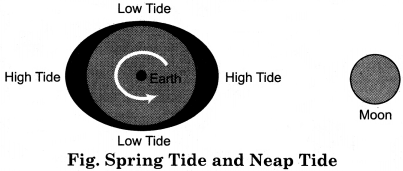
Question 3.
Defining ocean current, describe the various ocean currents of the world.
Answer:
The continuous flow of ocean water in a particular direction from one place of the ocean to another place is called Ocean Current. Water is stable on both the edges and below the current. In other words, ocean currents are similar to the rivers flowing on the land, but ocean currents are more dynamic than terrestrial rivers. According to Monkhouse, “The movement of current is in a certain direction.
Ocean Currents of the World:
Several water currents are found in the oceans of the world. These ocean currents are depicted in the following table:
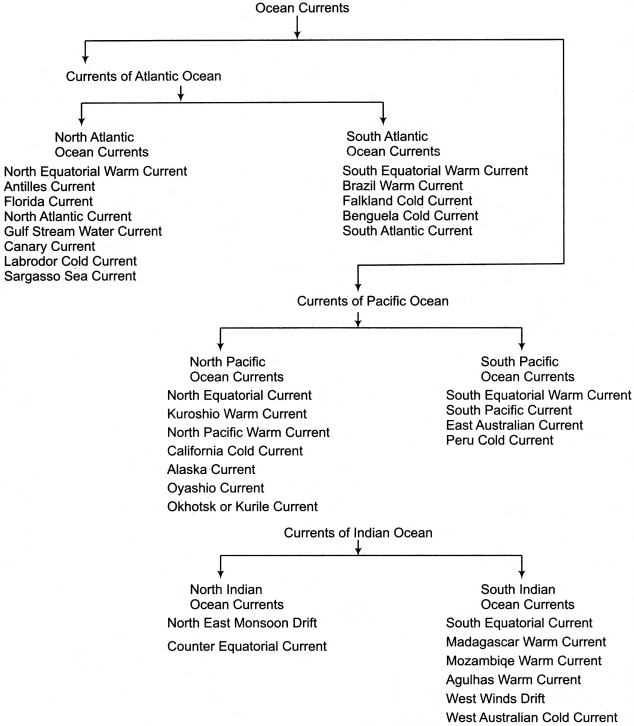
All these water currents found in the oceans of the world have been presented through the following map:
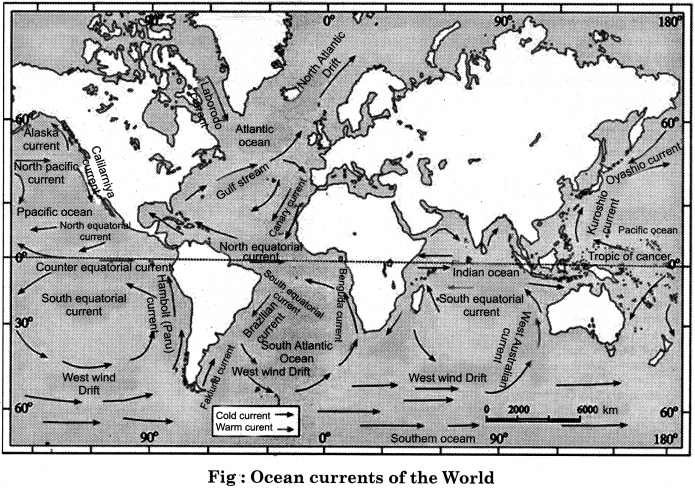
RBSE Class 11 Physical Geography Chapter 18 Other Important Questions
RBSE Class 11 Physical Geography Chapter 18 Multiple Choice Questions
Question 1.
The rise and fall of water by the friction of air on the sea surface is called:
(a) Flow
(b) Current
(c) Wave
(d) Tide
Answer:
(c) Wave
Question 2.
Who considered the waves as the turbulence in the liquid surface of the ocean?
(a) Richard
(b) Dailee
(c) Darwin
(d) Murray
Answer:
(a) Richard
Question 3.
Which of the following is not a type of wave?
(a) See
(b) Surf
(c) Swale
(d) Tide
Answer:
(d) Tide
Question 4.
Which of the following has more impact in the origin of tides?
(a) Sun
(b) Moon
(c) Earth
(d) None of these
Answer:
(b) Moon
Question 5.
In how many days does the moon complete one revolution of the earth?
(a) 30 days
(b) 28 days
(c) 27 1/2 days
(d) 27 1/3 days
Answer:
(b) 28 days
Question 6.
The lesser distance of the moon from the earth is called:
(a) Aphelion
(b) Perigee
(c) Perihelion
(d) Apogee
Answer:
(b) Perigee
Question 7.
Spring Tide occurs on:
(a) Day of New Moon
(b) Day of Full Moon
(c) Shukla – paksha Ashtami
(d) both (a) and (b)
Answer:
(d) both (a) and (b)
Question 8.
Where is the Oyashio Current found?
(a) in the eastern part of Asia
(b) in the Indian Ocean
(c) in the Northern Atlantic
(d) in the eastern part of Africa
Answer:
(a) in the eastern part of Asia
Matching Type Questions
Match the contents of Column A with that of Column B:
Question A.
| Column A (Name) | Column B (Condition of Water) |
| (i) Waves | (a) Water flowing-in a certain direction and a certain range. |
| (ii) Currents | (b) Commotion in water by the flow of air but no movement of water. |
| (iii) Ripples | (c) Rising up of the sea water by gravitational force. |
| (iv) Tide | (d) Falling down of the sea water. |
| (v) Ebb | (e) Motion of water in rocky form on the sea surface. |
Answers:
- (e)
- (a)
- (b)
- (c)
- (d)
Question B.
| Column A (Name of Current) | Column B (Flow Area) |
| (i) Benguela Current | (a) On the south – western coast of South Africa |
| (ii) East Australian Current | (b) On the eastern coast of Siberia |
| (iii) Kurile Current | (c) On the western coast of North America |
| (iv) Labrodor Current | (d) From Baffin Bay up to the Newfoundland projection |
| (v) California Current | (e) In the eastern part of Australia |
Answers:
- (a)
- (e)
- (b)
- (d)
- (c)
RBSE Class 11 Physical Geography Chapter 18 Very Short Answer Type Questions
Question 1.
How are the waves produced?
Answer:
Waves and ripples are produced in the water by the friction of oceanic water and air.
Question 2.
What is meant by wave ?
Answer:
Waves refer to the rocky motion of the water found on the ocean surface. In it, the level of water of the ocean rises up and falls down, but water does not move from its place to some other place.
Question 3.
What does See Wave mean?
Answer:
See:
When waves with different wave lengths or directions originate in the sea simultaneously, an irregular wave format is formed, which is called See.
Question 4.
What is Tsunami ?
Answer:
The high and destructive waves occurring in the oceanic regions due to the tectonic processes are called Tsunami.
Question 5.
How does the tides originate?
Answer:
The tides originate by the gravitational force of the earth, the moon and the sun.
Question 6.
What is meant by Perigee?
Answer:
When the moon is at the minimum distance (356000 km.) from the earth, such a situation is called Perigee.
Question 7.
What does Apogee mean?
Answer:
When the distance between the moon and the earth is the maximum, such a situation is called Apogee. In this situation, the distance between the moon and the earth is 407000 km.
Question 8.
What is meant by Aphelion?
Answer:
When the distance between- the earth and the sun is the maximum, it is called Aphelion. In this situation, the distance between the earth and the sun is 15.2 million km.
Question 9.
What does Perihelion mean?
Answer:
When the distance between the earth and the sun is the minimum, it is called Perihelion. In this situation, the distance between the earth and the sun is 14.7 million km.
Question 10.
What is the meaning of Daily Tides?
Answer:
Tide and Ebb occurring everyday at a place is called Daily Tide. This tide occurs everyday after an interval of 24 hours 52 minutes.
Question 11.
What is called Semi – Daily Tides?
Answer:
When the tides occur twice everyday at a place, such tides are called Semi – Daily Tides. In this, every tide occurs after an interval of 12 hours 26 minutes.
Question 12.
What is meant by the Mixed Tide ?
Answer:
Uneven semi – daily tides occurring in a place is called the Mixed Tide. In this, the height of both the tides is unequal.
Question 13.
What is meant by Ocean Currents ?
Answer:
An ocean current is a continuous flow of ocean water in a particular direction from one place of the ocean to another place.
Question 14.
How many types of currents are there on the basis of temperature?
Answer:
On the basis of temperature, there are two types of currents:
- Warm Currents.
- Cold Currents.
Question 15.
What is meant by Cold Currents?
Answer:
The currents which flow from cold regions towards hot regions are called cold currents. These currents flow from the poles towards the equator. The temperature of their water is low, due to which they reduce the temperature of the regions in which they flow.
Question 16.
Where does the Alaska Current flow?
Answer:
Alaska Current flows along the western coast of North America from the south towards the north.
Question 17.
Explain the North Equatorial Warm (Atlantic ocean) Current.
Answer:
This warm current flows between 5 degree and 20 degree northern latitudes near the equator. It flows from the coast of Africa in the east to the western islands. This current was firstly mentioned by Findley (1853).
Question 18.
What does the South Atlantic Drift mean?
Answer:
With the effect of rapid West Winds, the water flows between 40 degree and 60 degree southern latitudes from the west towards the east. This is actually the eastern extension of the Brazil Current, but its nature changes.
Question 19.
Explain the Kuroshio Warm Current.
Answer:
The North Equatorial Current, after reaching the Philippine Islands, starts flowing in north direction along the coast of Taiwan and Japan and is known by the name of Kuroshio Current.
Question 20.
What is meant by West Australian Current?
Answer:
This is a cold water current. One branch of the West Winds Drift flows through the south of Australia and the other branch turns north from the west coast of Australia. This second branch is called the West Australian Current.
RBSE Class 11 Physical Geography Chapter 18 Short Answer Type Questions (SA-I)
Question 1.
How many parts of wave are found in the structure of the waves?
Answer:
In the structure of the waves, the following parts of wave are found:
1. Wave Crest:
The crest of a wave is the point on the medium that exhibits the maximum amount of positive or upward displacement from the rest position.
2. Wave Trough:
The trough of a wave is the point on the medium that exhibits the maximum amount of negative or downward displacement from the rest position.
3. Wave Length:
The distance between two successive crests of a wave is called its wave length.
Question 2.
Clarify the difference between Warm and Cold Currents.
Answer:
The following differences are found between the Warm Currents and the Cold Currents:
| Basis of Difference | Warm Currents | Cold Currents |
| Flow of currents 1 | These currents flow from hot regions towards cold regions. | These currents flow from cold regions towards hot regions. |
| Flow on Latitudinal Basis | These currents flow from the equatorial regions towards the poles. | These currents flow from the poles towards the equatorial regions. |
| Effect of Temperature | These currents increase the temperature of the regions through which they flow. | These currents decrease the temperature of the regions through which they flow. |
| Temperature of the water of currents | The temperature of the water of these currents is high. | The temperature of the water of these currents is low. |
Question 3.
Explain the factors responsible for the origin of currents.
Answer:
For the origin of currents occurring in the oceanic regions, the following factors are held responsible:
1. Nature of the Earth:
Gravitational Force, Rotation
2. External Ocean Causes:
Atmospheric Pressure and Winds, Evaporation and Rainfall
3. Internal Ocean Causes:
Pressure, Temperature, Salinity, Density, Snow – melting.
4. Factors That Transform the Currents:
Shape of Coastline, Climatic Change, Structure of oceanic bottom, etc.
Question 4.
Explain the difference between Gulf Stream and Labrodor Current.
Answer:
The following differences are found between Gulf Stream and Labrador Current:
| Basis of Difference | Gulf Stream | Labrador Current |
| Nature | This is a warm water current. | This is a cold water current. |
| Direction of Flow | This water current flows mainly from the South towards the North-East. | This water current flows from the North towards the South – East. |
| Regions | This water current flows in the south – eastern part of North America. | This water current flows along the North – Eastern part of America to the Gulf of Baffin and New found – land projection. |
| Area of Origin | The origin of this current is Equatorial. | The origin of this current is Polar. |
| Temperature of Water | The temperature of water of this current is high. | The temperature of water of this current is low. |
Question 5.
What are the differences between Oyashio current and Kuroshio current?
Or
How is the Oyashio current different from the Kuroshio current?
Answer:
The following differences are found between Oyashio current and Kuroshio current.
| Basis of Difference | Oyashio Current | Kuroshio Current |
| Nature | This is a cold water current. | This is a warm water current. |
| Direction of Flow | This water current flows from the north towards the south. | This water current flows from the coast of Japan towards the north. |
| Area of origin | The origin of this water current is polar. | The origin of this water current is equatorial. |
| Regions | This water current flows from Bering Strait to near the eastern coast of Kamchatka peninsula. | This water current flows along Philippine Islands and the coast of Taiwan and Japan. |
| Temperature of Water | The temperature of this water current is low. | The temperature of this water current is high. |
RBSE Class 11 Physical Geography Chapter 18 Short Answer Type Questions (SA-II)
Question 1.
What does the term Ocean Waves mean? Explain.
Answer:
The waves always rise and fall on the surface of the ocean water. According to Richard, “Waves are the turbulence of the liquid surface of the ocean.” This is the most extensive and ubiquitous motion of the ocean water. There are two main causes of the origin of ocean waves:
- By the blowing of winds.
- When water surface becomes wavy by the motion in the earth’s crust.
Waves are the rocky motion on the ocean surface. In this, the water level of ocean rises up and falls down, but water does not move from its place to another place. If a floating object (like : a piece of wood) is thrown at the water level, then it will sway back and forth, up and down at its own place, while the waves will appear flowing further.
Question 2.
Explain the difference found in the time of tides.
Or
Why is the difference found in the time of tides?
Answer:
Tide occurs on every place after an interval of 12 hours 26 minutes. Earth completes a rotation op. its axis in 24 hrs. In this way, tide should occur on every place after 12 hrs, but it is not like that. The main reason for this difference is that on the completion of one rotation of the earth, the moon also moves on its path.
Moon completes the revolution of the earth in 28 days. In 24 hrs or 1 day, it completes 1/28 part of the circle. That location of the earth takes 52 minutes to come in front of the moon. Thus, on every place, the second tide occurs after an interval of 12 hrs 26 mins. This situation of the tide can be explained with the help of the following diagram:
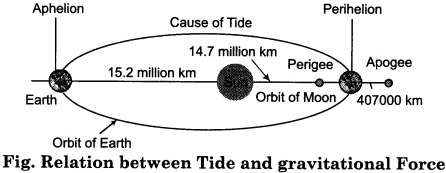
Question 3.
Explain the benefits of tides.
Answer:
The benefits of tides are as follows:
- Tides are the source of energy because energy can be generated from the water rising up and falling down. Tidal energy is used in France and Japan.
- The world’s biggest harbours are located far from the sea at the mouth of the river (London, Kolkata etc). Ships can come in along with tidal water.
- Fishing sailors go for fishing in open sea with the tide, and return back to the safe coast with the help of ebb.
- The return wave of tide takes away all the filth of towns settled on the coast into the sea.
- The return wave of tide leaves various maritime objects (like – shells, snails etc.) on the coast.
- Due to the tide, the sea water remains dynamic and clean and the water does not stagnate.
Question 4.
Explain the currents of the South Atlantic Ocean.
Answer:
The cold and warm water currents found in the South Atlantic Ocean are as follows:
1. South Equatorial Warm Current:
This current flows in the south of equator to its parallel from the east towards the west.
2. Brazil Warm Current:
South Equatorial Current arrives in the west and starts flowing along the coast of Brazil.
3. Falkland Cold Current:
This current flows along the south – east coast of South America from the south towards the north. It carries snowy rocks with its flow from the Antarctica region. Here, the mist is found all around due to the merging of cold and warm water.
4. Benguela Cold Current:
This current flows towards the north along the south-western coast of Africa. It is an irregular and weak current.
5. South Atlantic Drift:
With the effect of fast West Winds, the water flows between 40 degree and 60 degree southern latitudes from the west towards the east. This is actually the eastern extension of the Brazil Current, but its nature changes.
RBSE Class 11 Physical Geography Chapter 18 Essay Type Questions
Question 1.
Explain the currents of the North Atlantic Ocean.
Or
Explain the currents flowing in the northern part of the Atlantic Ocean along with a diagram.
Answer:
Atlantic Ocean is a semi-ocean is the second largest ocean in the world after the Pacific Ocean. Its shape is similar to the letter ‘S’ of the English alphabet. The equator divides this ocean into two parts. The part of this ocean parting from the equator to the north is called the North Atlantic Ocean. The expansion of the South Atlantic Ocean is found in the part south of the equator. The cold and warm water currents flow in the North Atlantic Ocean, whose description is as follows:

1. North Equatorial Warm Current:
This warm current flows between 5 degree and 20 degree northern latitudes near the equator. This flows from the coast of Africa in the east to the western islands. This current was firstly mentioned by Findley in the year 1853.
2. Antilles Warm Current:
South Equatorial Current divides into two parts near the Cape Sao Roque of Brazil. The northern branch joins the North Equatorial Current and enters into the Caribbean Sea and the Gulf of Mexico. Its remaining part on the eastern edge of the Western Islands is known by the name of Antilles Current.
3. Florida Current:
This is actually an extension of the North Equatorial Current which enters the Gulf of Mexico through Yucatan Channel. Its features are similar to the equatorial water body.
4. North Atlantic Current:
On the Gulf Stream, away from Grand Bank, the effect of the westerlies Winds is clearly visible. It turns to the east.
5. Gulf Stream Warm Current:
From the Cape Hatteras to Grand Bank, this current is called Gulf Stream. The Gulf Stream receives a considerable amount of hot water in the Gulf of Mexico which it carries to the cold regions.
6. Canary Current:
This is the cold water current. It flows between western coast Madeira of North Africa and Cape Verde Islands. The warm water of Gulf Stream changes into cold current on reaching here. This current, eventually, merges into the North Equatorial Current. The seasonal changes occur in this current.
7. Labrador Cold Current:
This is the cold current flowing in the North Atlantic Ocean which flows towards the south from the Gulf of Baffin to Davis Strait. This current works to balance the oceanic bottom. Dense fog is found around Newfoundland due to the merging of hot and cold water. This is an ideal condition for the fishery industry.
8. Sargasso Sea:
Nearly calm and sedentary water area located in the intermediate part of the North Atlantic Ocean, which is surrounded by the regular and uninterrupted flow order of the North Equatorial Current, Gulf Stream and Canary Current is called the Sargasso Sea. The thick sea grass floats on its coast. This grass is called sargassum in Portuguese language. On the name of this grass only, it is termed as Sargasso Sea. Its area is about 11,000 sq. km.
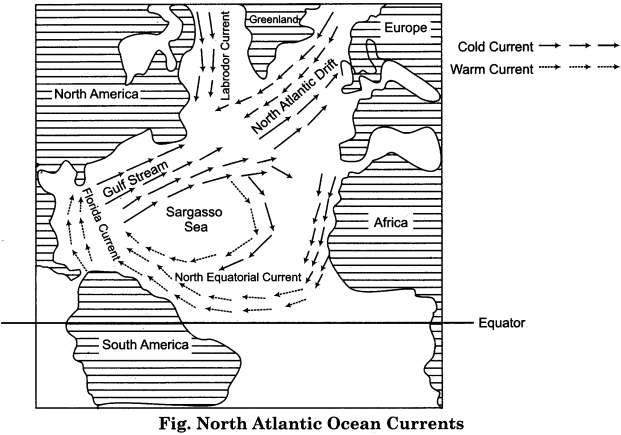
Question 2.
Explain the currents of Pacific Ocean.
Answer:
The Pacific Ocean is the largest ocean of the world in terms of area. It is an ocean which spreads towards both the sides, the east and the west, of the continental parts. The East Pacific Ocean is spread to the west of American Continents. The West Pacific Ocean is spread to the east of Asia continent. The equator divides this ocean into two parts. The part which is parting from the equator to the north is called the North Pacific Ocean and the part extended towards the south of equator is called the South Pacific Ocean.
In terms of study, the currents of Pacific Ocean are also classified into the currents of the North and the South Pacific Ocean, which are as follows:
Currents of the North Pacific Ocean:
1. North Equatorial Current:
This current flowing from the east towards the west. It begins from the west coast of the Central America and reaches the Philippine Islands.
2. Kuroshio Warm Current:
The North Equatorial Current, after reaching the Philippine Islands, starts flowing in north direction along the coast of Taiwan and Japan and is known by the name Kuroshio Current.
3. North Pacific Warm Current:
After reaching the south – eastern coast of Japan, the Kuroshio Current by effect of the prevailing West Winds, starts flowing from the west of the ocean to the east.
4. California Cold Current:
This is considered as an extension of the North Pacific Current because it flows from cold regions to hot regions. Thus, it is called the California Cold Current.
5. Alaska Current:
On the west coast of North America, the second current of the North Pacific Ocean turns to the north in anti – clockwise direction.
6. Oyashio Cold Current:
This is the cold water current which flows from north to south from Bering Strait to near the eastern coast of Kamchatka Peninsula.
7. Okhotsk or Kurile Cold Current:
This current starts from Okhotsk Sea flows along the eastern coast of Sakhalin Island, and joins Oyashio Current near Hokkaido Island of Japan.
Currents of the South Pacific Ocean:
1. South Equatorial Warm Current:
This is a warm water current which flows from the coast of Central America in east to the eastern coast of Australia in west.
2. South Pacific Current:
This East Australian Current near Tasmania comes under the influence of West Winds and starts flowing from west to east. Here, it is known by the name South Pacific Current.
3. East Australian Warm Current:
This is a warm water current. It flows along the eastern coast of Australia.
4. Peru Cold Current:
This current on reaching the south-western part of South America turns to the north and starts flowing along the coast of Peru. It flows from cold regions to hot regions.
All these currents of the Pacific Ocean are being presented as follows:
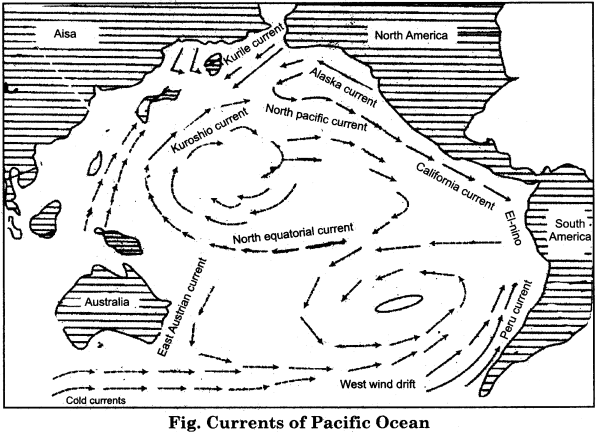
Question 3.
Explain the currents of Indian Ocean.
Answer:
Indian Ocean is the third largest ocean of the world in terms of area. A very less part of it lies to the north of the equator. According to its shape, its expansion towards north is less and more in the south. On this basis, the currents of Indian Ocean are classified into North Indian Ocean Currents and South Indian Ocean Currents. Their description is as follows:
Currents of North Indian Ocean:
1. North – East Monsoon Drift:
It is also called North – East Monsoon Runoff. This drift starts from Malacca Strait and enters the Arabian Sea flowing along the coast of the Bay of Bengal.
2. Counter Equatorial Current:
This current starts near Zanzibar Island in the west and flows eastward.
Currents of South Indian Ocean:
1. South Equatorial Current:
This current flows from east to west in the south near the equator.
2. Madagascar Warm Current:
The branch of the South Equatorial Current flowing on the eastern coast of Madagascar Island is called Madagascar Current.
3. Mozambiqe Warm Current:
On reaching Madagascar Island, the South Equatorial Current divides into two branches. One of the branches flows towards the south along Madagascar Island and the other branch enters into Mozambiqe Channel.
4. Agulhas Warm Current:
The Madagascar Current and the Mozambiqe Current in south along Madagascar Island merge and become united. This joint current is called Agulhas Current.
5. West Winds Drift:
This flows from west to east in the south of Indian Ocean and reaches near the southern tip of west coast of Australia.
6. West Australian Cold Current:
One branch of the West Winds Drift flows through the south of Australia and the other branch turns to the north from the western coast of Australia. This second branch is called the West Australian Cold Current.
These currents of the Indian Ocean are being presented with the help of following fig.
